If you are a gardener looking for a new passion, then growing Asiatic lilies may be the perfect fit. Their vibrant colors are an ideal way to add color to your garden’s landscape. While you do need to give them a little care, they will thrive in many environments. Following the advice in this Asiatic lily growing guide will hopefully get you off to a great start.

Today I invited Dean, a former plant biologist who publishes at Gardener’s HQ to share his knowledge of growing one of his favorite lilies.
What are Asiatic Lilies?
Many people think that Asiatic lilies are the same as Oriental lilies, but that is not really the case. There are numerous key differences in these members of the Lilium flower genus:
- Asiatic lilies are native to several parts of China and Japan while Oriental lilies are native to Japan.
- Asiatic lilies grow from one to six feet tall while Oriental lilies grow from two-to-eight feet tall.
- The leaves of Asiatic lily plants are slender and a glossy green, while those of Oriental lily are darker green and almost heart-shaped.
- Oriental lily leaves are also more widely spaced than those on an Asiatic lily.
- While most Oriental lilies carry white or pastel blooms, a much wider range of colors is available in Asiatic lilies.
- If you smell a lily’s flower and it has a fragrance, then it is an Oriental lily.
Types and Cultivars of Asiatic Lilies
There are many types of Asiatic lilies, so you can easily find one that looks perfect for your landscaping needs. You may want to consider these options:
Tiger lilies (Lilium Tigrinum)
These bright orange lilies bloom in mid-summer. While sun-loving, these lilies will also tolerate a little shade. They have upright stalks that grow to be about 3.5 feet tall, and their bright blooms make them a suitable choice when placed among dark-colored ferns.
When cut, these flowers will last about two weeks in a vase. So long as the soil is well-drained and they get enough light, they are not picky about where they are grown and can be grown in containers.
Whip-poor-will Flower (L. Cernuum)
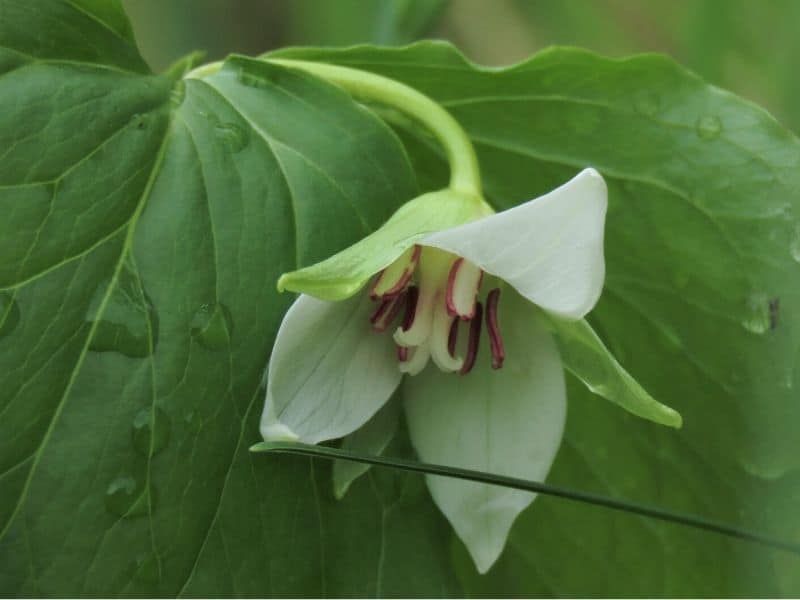
These white flowers bloom in late spring. They take their name from the way the three white wavy flowers with deep rose anthers droop and hide under the whorl of three large leaves.
These lilies grow to be about 3-feet tall prefer sandy soil. Unlike tiger lilies, these plants prefer the shade, and they require good cover if you plan to overwinter your bulbs.
Forever Susan (Lilium Forever Susan)

Stunning burgundy-and-yellow lilies grow to about 2.5-feet tall and bloom at the beginning of summer. They have a strong preference for organic soil and require at least several hours of sun daily.
These lilies prefer the soil to be a little damp, but it is important not to plant them in a place where they will stand in water to prevent root rot. For the best color, plant in groups of at least three in a pot or the ground.
Commander in Chief (Lilium Commander in Chief)
Asiatic Lily, (Commander in Chief Lily) Perennial – Bag of 4
The 7-inch scarlet red blooms on this Asiatic lily are a real showstopper. This lily blooms mid-summer and grows to be about 3-feet tall. It does well in full sun or partial shade. It requires well-drained soil.
Connecticut King (Lilium Connecticut King)
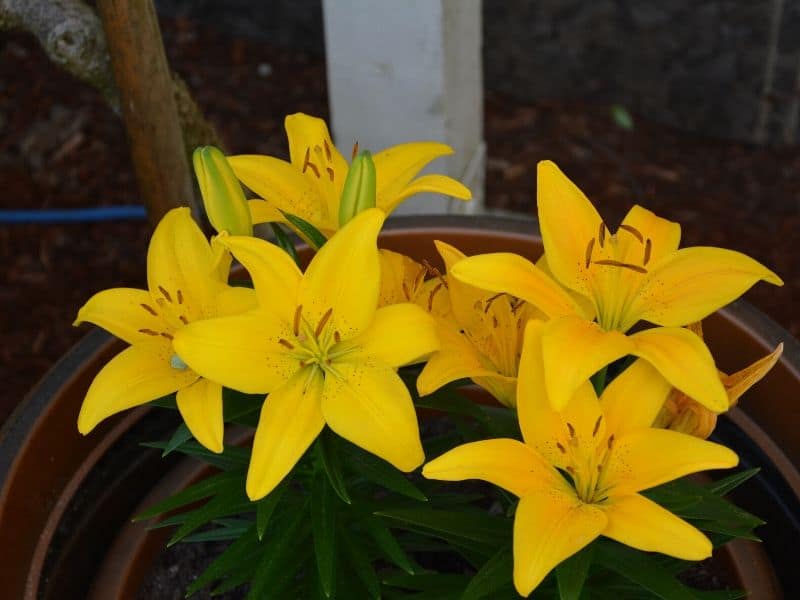
These buttercup-yellow lilies grow to be about 3-feet tall. Choosing a spot to plant them can be a little tricky because they produce their best blooms when their tops get exposed to full sun, but their roots need shade. While these flowers put on a beautiful display in your garden, they also do very well as cut flowers.
Pictures of Asiatic Lilies From My Garden
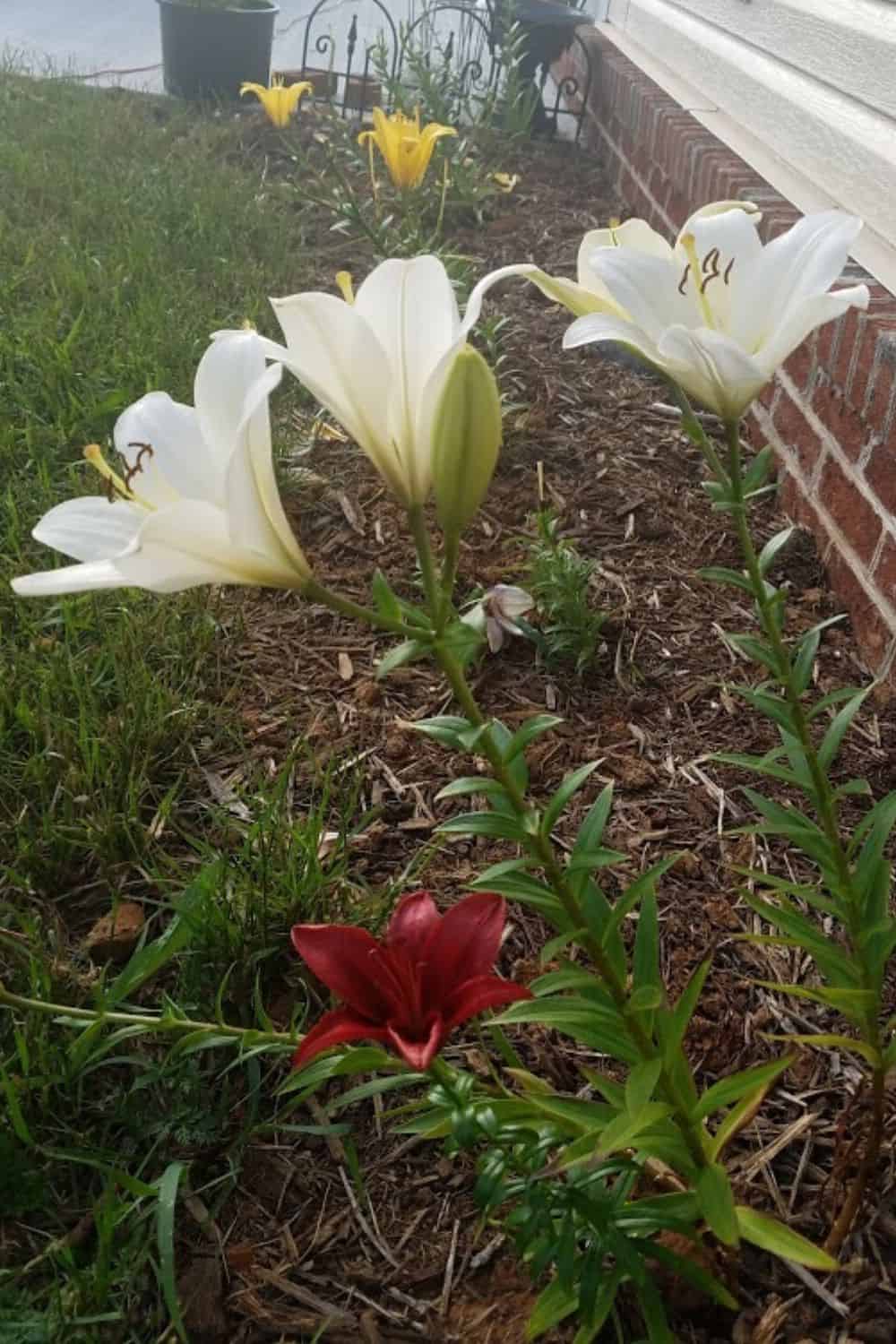
This spring, while visiting a friend who bought a property and was cleaning it out, I noticed he had some buckets filled to the brim with crowded greens coming up. He had no clue what they were and I offered to take them off his hands. When I got home and took everything out, I found a couple of tags that said Asiatic Lillies.
I knew nothing about these flowers, but happily did a bit of research and planted some next to our garage and some in front of the house. It was so much fun to see them bloom, al in different colors! Take a peek.
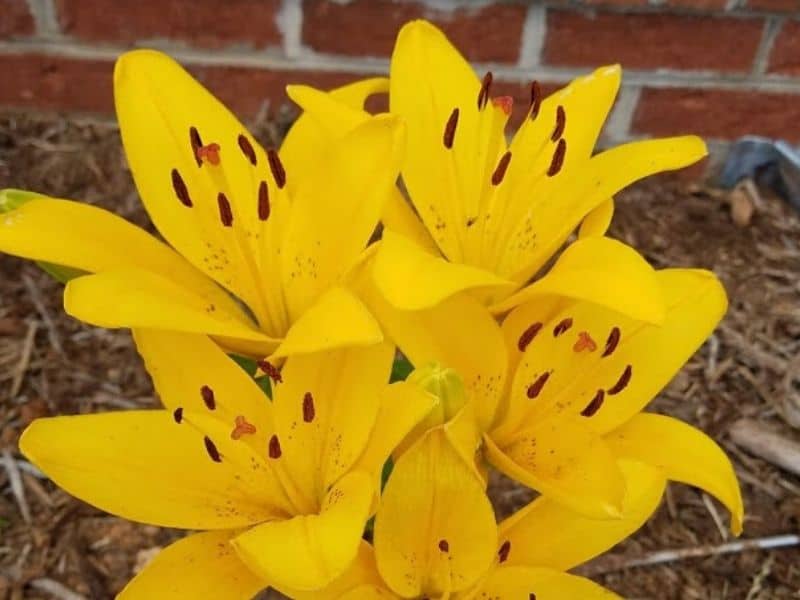
These yellow ones bloomed first, and I love them! So bright and cheery!
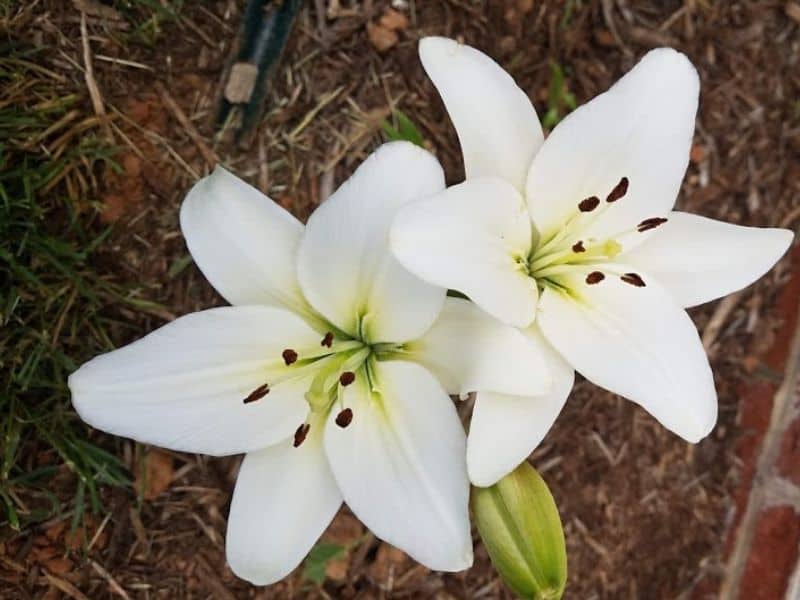
The white ones were next: big and beautiful!
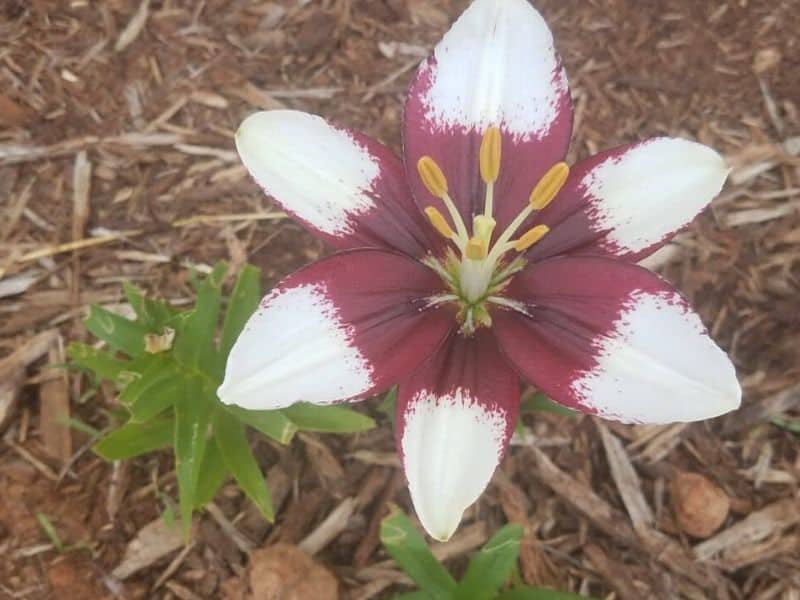
This was such a nice surprise! I didn’t know Asiatic lilies came in 2 colors. Sadly, we only had one bloom like this.
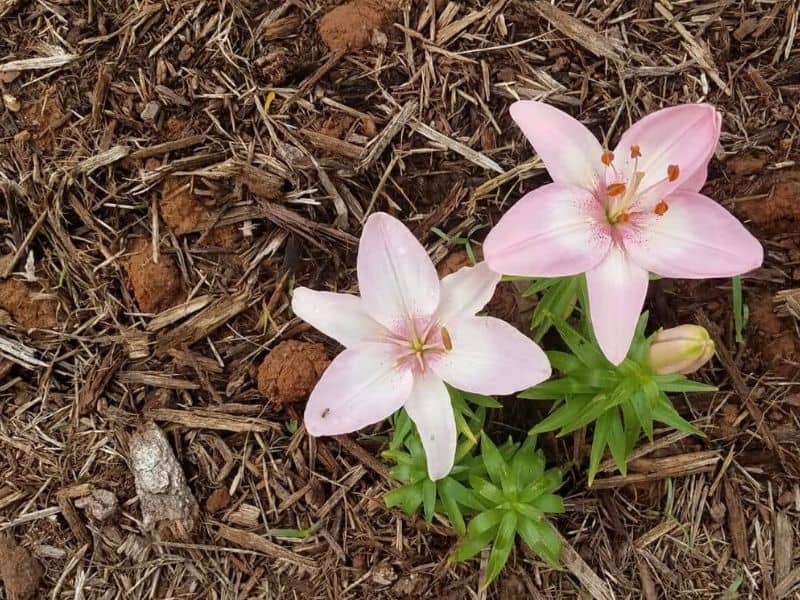
These pink ones were much smaller (shorter) than the rest. If I remember correctly, the bulbs were much smaller than the rest when we planted them. I love that they too are made up of two colors, even though much paler than the previous one.

These were the last ones to bloom. We planted them in the front of the house, where there’s a lot less sun, so it took them a while to mature. Sooo pretty! I took this picture after a good rain 🙂
How to Grow Asiatic Lilies
Following the advice in this care guide will make it easy to grow Asiatic lilies and hybrids. Ideally, you should buy lily bulbs close to when you plan on planting them. This is because these bulbs are more delicate than many other bulbs, and they will deteriorate over time.
Buy Asiatic lily bulbs
Forever Susan Asiatic Lily 2 Bulbs 14/16 cm – Orange & Plum Mggsndi 100Pcs Rare Lily Bulbs
Mggsndi 100Pcs Rare Lily Bulbs  Stargazer Oriental Lily
Stargazer Oriental Lily Asiatic Lily Bulbs – Starlette – Bag of 5
Asiatic Lily Bulbs – Starlette – Bag of 5 Meflying Stargazer Lily Bulbs – Jumbo Pack
Meflying Stargazer Lily Bulbs – Jumbo Pack Spring Pink Double Asiatic Lily
Spring Pink Double Asiatic Lily 5 Lily Bulbs Asiatic Lily Orange County
5 Lily Bulbs Asiatic Lily Orange County Black Eye Asiatic Lily – 2 Bulbs 14/16cm – Spotted White with Black Eye
Black Eye Asiatic Lily – 2 Bulbs 14/16cm – Spotted White with Black Eye Gorgeous Mixed Asiatic Lily Bulbs Flowering Perennial Year After Year
Gorgeous Mixed Asiatic Lily Bulbs Flowering Perennial Year After Year Spectacular Red Asiatic Lily Bulbs Flowering Perennial Year After Year
Spectacular Red Asiatic Lily Bulbs Flowering Perennial Year After Year Gorgeous Pink Asiatic Lily Bulbs Flowering Perennial Year After Year
Gorgeous Pink Asiatic Lily Bulbs Flowering Perennial Year After Year Asiatic Lily Bulbs – Black Wizard – Fragrant Perennial – Dark Burgundy
Asiatic Lily Bulbs – Black Wizard – Fragrant Perennial – Dark Burgundy
The good news is that almost anyone can grow Asiatic lilies. But be sure to choose the right location for the variety that you plan on planting.
Generally, lilies do best when their tops get at least a few hours of sun each day. They make a great companion plant because their roots prefer to be in the shade.
While some varieties are more tolerant of dry conditions than others, Asiatic lilies do not like to stand in water, so make sure the site you choose drains well. Working peat moss, sand, or straw into the soil before planting can help the soil drain better.
If you are planting in the ground, then plant the bulbs in the fall. They need to sit in the ground over the colder winter months to develop a strong root structure. Plant the bulbs in a hole that is 3-inches deeper than the height of the bulb.
Then, fill the hole lightly with soil and mulch the top.
Asiatic Lily Care
Once you planted your lilies, you may also want to add some slow-release fertilizer.
When the lilies start to poke their heads through the ground in the spring, feed it again with high-phosphorous fertilizer or bone meal. While this can help lilies put on showier blooms, be sure to use only the recommended amount or you will damage the plant.
Generally, Asiatic lilies need about two inches of water per week. If temperatures get very hot, then it may need a little more. A drip hose is a great option.
Consider mulching around the roots so that the roots stay damp without standing in water.
Make sure you stake your lilies. They grow tall and wind can knock them over. Also, the blooms are sometimes so heavy that the stalk leans to the ground. You can avoid that by propping them up with one of these stakes.
After the flower fades, then you should pick off the dead flower. On most Asiatic lilies, once the stem turns yellow, you will want to cut it off at the ground and mulch over it.
Be sure, however, to read the instructions that come with your variety as pruning requirements vary a bit between different choices. Then, apply a slow-release fertilizer and mulch well.
About every three to five years, you should divide your lilies. Do this in the spring, as you start to see new growth. Lift the plant out of the ground, and separate the roots. Then, replant your lilies after adding a little compost to the hole.
Final Thoughts
Asiatic lilies are easy to grow, and you can find so many different choices that you are sure to find one or more that you adore. Now that you know how to grow these gorgeous flowers you need to be careful. Why? Well, growing different Asiatic lily varieties can become an addicting hobby. Thankfully, they are easy to care for making them an ideal plant to grow in the garden for the busier gardener.


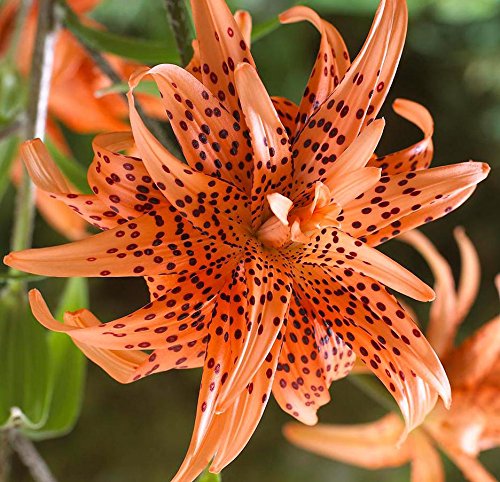






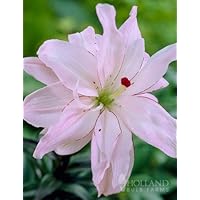




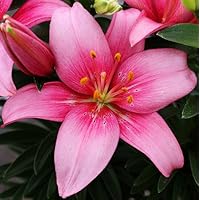


21 Best Companion Plants For Daylilies
Monday 13th of June 2022
[…] Check out our guide to growing Asiatic lilies. […]
Beautiful Flower Garden Ideas
Saturday 6th of March 2021
[…] Asiatic Lilies Growing Guide […]
Cveta's Delightful Mediterranean Style Garden
Wednesday 22nd of July 2020
[…] planted a few colors of lilies: orange, yellow, and white. Here’s how to grow asiatic lilies: […]